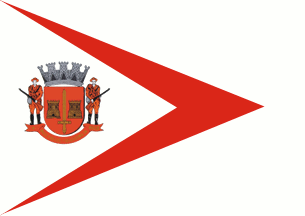 image located by Aleksandar Nemet, 7 May
2010
image located by Aleksandar Nemet, 7 May
2010
Last modified: 2012-11-05 by ian macdonald
Keywords: sao paulo | buri |
Links: FOTW homepage |
search |
disclaimer and copyright |
write us |
mirrors
 image located by Aleksandar Nemet, 7 May
2010
image located by Aleksandar Nemet, 7 May
2010
based on http://buri.sp.gov.br/historia/simbolos/51-bandeira/99-bandeira-de-buri
"The Flag of Buri, is described thus:
Rectangular, white with a
red isosceles triangle, extending from the hoist, charged with a white triangle,
overlain by the coat of arms. The flag of Buri has the proportions of the
National Flag, i.e. 14 (fourteen) modules high by 20 (twenty) modules in length, the red
triangle has the base coincident with the hoist and 17.5 (seventeen and a half)
modules height and the triangle that it is superimposed on the base of the first
and 12 (twelve) modules in height, with the coat of arms is five (5) modules in
height.
The triangles superimposed, form a red spearhead, indicating the
forward momentum, even at the expense of the greatest sacrifices, developed by
the people of Buri."
translated from
http://buri.sp.gov.br/historia/simbolos/51-bandeira/99-bandeira-de-buri.
Aleksandar Nemet, 7 May 2010
Official website at http://buri.sp.gov.br
Dirk Schönberger,
4 October 2012
Buri is named for the palm tree locally known as "buri" or "buriti" (Mauritia flexuosa L.f., moriche palm). The village emerged, as Porto do Apiaí, near a crossing of river Apiaí used by cowboys driving their carts to the south via Itapetininga and Sorocaba. Thanks to the pastures and the fertile soil, Porto do Apiaí became a significant settlement, with a church built in 1884-1888. The district of Porto do Apiaí, part of the municipality of Itapeva da Faxina, was established on 18 November 1895. The arrival in 1907 of the Sorocaba Railways boosted even more the development of the village. The municipality of Buri was established on 1 December 1921 by Law No. 1,805 and inaugurated on 25 January 1922.
The coat of arms of Buri, designed by Lauro Ribeiro Escobar, is "a rounded-off shield, gules a Roman sword surrounded by two towers of the same masoned port and windows sable. The shield surmounted by an eight-towered mural crown argent ports sable. The shield supported by the volunteers of the Constitutionalist Army raising their weapon in a bellicose posture. Below the shield a scroll gules inscribed with the motto 'IN PACE FIDELIS, FIDELISSIMA IN BELLO' (Faithful in Peacetime, Even More Faithful in Wartime)."
The rounded-off, or Iberic shield, used in Portugal at the time of
discovery of Brazil, is a tribute to the early colonizers and builders
of the country.
Gules (red) is a symbol of audacity, valour, fierceness, intrepidity,
honour, nobleness, and blood shed on battlefields, characteristic of
the inhabitants of Buri, as emphasized in 1932 in their struggle
against tyranny and to protect the Law.
The sword is a symbol of war and justice, evoking the sword raised by
São Paulo in 1932 to protect the Law and to demand a democratic
Constitution.
The towers are emblems of force, constancy, magnanimity, and defence.
Or is a symbol of wealth, splendour, glory, nobleness, power, force,
faith, prosperity, sovereignty and rule.
The mural crown is a symbol of municipal emancipation. The open ports
means hospitality.
The supporters recall, once more, that Buri was a heroic, martyr,
intrepid and faithful town during he Constitutionalist Revolution.
http://buri.sp.gov.br/historia/simbolos/50-brasao/100-brasao -
Municipal website
Ivan Sache, 5 November 2012